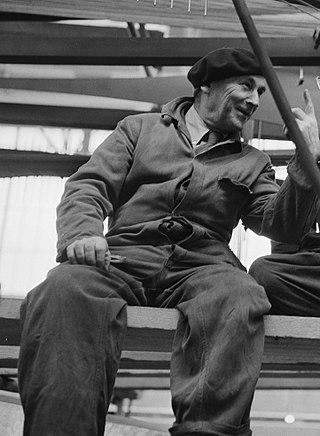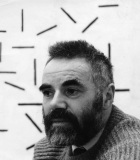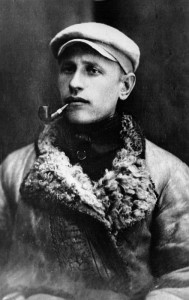Related Research Articles

Naum Gabo was an influential sculptor, theorist, and key figure in Russia's post-Revolution avant-garde and the subsequent development of twentieth-century sculpture. His work combined geometric abstraction with a dynamic organization of form in small reliefs and constructions, monumental public sculpture and pioneering kinetic works that assimilated new materials such as nylon, wire, lucite and semi-transparent materials, glass and metal. Responding to the scientific and political revolutions of his age, Gabo led an eventful and peripatetic life, moving to Berlin, Paris, Oslo, Moscow, London, and finally the United States, and within the circles of the major avant-garde movements of the day, including Cubism, Futurism, Constructivism, the Bauhaus, de Stijl and the Abstraction-Création group. Two preoccupations, unique to Gabo, were his interest in representing negative space—"released from any closed volume" or mass—and time. He famously explored the former idea in his Linear Construction works (1942-1971)—used nylon filament to create voids or interior spaces as "concrete" as the elements of solid mass—and the latter in his pioneering work, Kinetic Sculpture (1920), often considered the first kinetic work of art.
Sir Terence Orby Conran was a British designer, restaurateur, retailer and writer. He founded the Design Museum in Shad Thames, London in 1989. The British designer Thomas Heatherwick said that Conran "moved Britain forward to make it an influence around the world." Edward Barber, from the British design team Barber & Osgerby, described Conran as "the most passionate man in Britain when it comes to design, and his central idea has always been 'Design is there to improve your life.'" The satirist Craig Brown once joked that before Conran "there were no chairs and no France."

Abstraction-Création was a loose association of artists formed in Paris in 1931 to counteract the influence of the Surrealist group led by André Breton.

Constructivism is an early twentieth-century art movement founded in 1915 by Vladimir Tatlin and Alexander Rodchenko. Abstract and austere, constructivist art aimed to reflect modern industrial society and urban space. The movement rejected decorative stylization in favour of the industrial assemblage of materials. Constructivists were in favour of art for propaganda and social purposes, and were associated with Soviet socialism, the Bolsheviks and the Russian avant-garde.

Edwin John Victor Pasmore, CH, CBE was a British artist. He pioneered the development of abstract art in Britain in the 1940s and 1950s.
Kenneth Laurence Martin, was an English painter and sculptor who, with his wife Mary Martin and Victor Pasmore, was a leading figure in the revival of Constructionism.
John Ernest was an American-born constructivist abstract artist. He was born in Philadelphia, in 1922. After living and working in Sweden and Paris from 1946 to 1951, he moved to London, England, where he lived and worked from 1951. As a mature student at Saint Martin's School of Art he came under the influence of Victor Pasmore and other proponents of constructivism. During the 1950s, Ernest exhibited with the British Constructivist art movement. Ernest later became a core member of the Systems Group.

Anthony Cedric Graham Hill, also known as Achill Redo, was an English painter, relief-maker, and mathematician.

Peter Lowe is an English artist, born in Hackney, London. His work is systematic, constructivist and concrete. It is mainly exhibited and appreciated in Europe, where it is held in many national collections.
Paule Vézelay was a British painter, known for her abstract art.
Gillian Mary Wise was a British artist devoted to the application of concepts of rationality and aesthetic order to abstract paintings and reliefs. Between 1972 and 1990 she was known as Gillian Wise Ciobotaru.
Robert Adams was an English sculptor and designer. Whilst not widely known outside of artistic circles, he was nonetheless regarded as one of the foremost sculptors of his generation. In a critical review of a retrospective mounted by the Gimpel Fils gallery in London in 1993, Brian Glasser of Time Out magazine described Adams as "the neglected genius of post-war British sculpture", a sentiment echoed by Tim Hilton in the Sunday Independent, who ranked Adams' work above that of his contemporaries, Ken Armitage, Reg Butler, Lynn Chadwick and Bernard Meadows.

Jeffrey Steele (1931–2021) was an abstract painter and founder of the Systems Group.

Karlis Johansson was a Latvian-Soviet avant-garde artist.
The Systems Group was a group of British artists working in the constructivist tradition. The group was formed after an inaugural Helsinki exhibition in 1969 entitled Systeemi•System. The exhibition coordinator Jeffrey Steele together with Malcolm Hughes, invited the participating artists to form a group in 1970. The Systems Group had no manifesto and no formal membership; it existed for the purpose of discussion and exhibition rather than direct collaboration.

David Saunders is an English artist, teacher and musician. Over his long career Saunders's work has undergone some changes but is best known for his systematic and constructivist style which he practised from the late 1960s to the mid 1990s. He is mainly exhibited and appreciated in the UK and Europe, where his work is held in many national collections.
Colin Jones is an English artist and sculptor whose work has been regarded as constructive and systematic. His works have been exhibited and preserved in several public collections in England, including the Arts Council and the Tate gallery.
Vera Spencer was a British painter and textile designer, whose work has been described as constructivist and modernist. Her work is exhibited and preserved in several public collections, including the Arts Council, the Tate gallery. Art historian Herta Wescher was a keen collector of her work.
Groupe Espace was a French avant-garde artistic movement between 1951 and 1960. The group was founded by architect André Bloc in 1951 and members associated with the journal Art d'Aujourd'hui [Art Today]. Their purpose was to create a new environment appropriate to modern society. They envisaged art as a social phenomenon - not an individual one.
Raymond Elston was a British textile designer, furniture designer and abstract artist. He was influenced by abstract expressionism and modernist principles and is remembered for his early work with the fashion and furniture designer Terence Conran, and for the mobiles he exhibited in the early 1950s with the Constructionist Group.
References
- ↑ Fowler, Alan (2006), Constructivist Art in Britain 1913–2005, University of Southampton, Winchester School of Art, p. 20
- ↑ Fowler, Alan (2006), Constructivist Art in Britain 1913–2005, University of Southampton, Winchester School of Art, p. 10
- ↑ Fowler, Alan (2006), Constructivist Art in Britain 1913–2005, University of Southampton, Winchester School of Art, p. 68
- ↑ Grieve, Alastair (2005), Constructed Abstract Art in England After the Second World War: A Neglected Avant-Garde, Yale University Press, ISBN 978-0-300-10703-6
- ↑ Fowler, Alan (2006), Constructivist Art in Britain 1913–2005, University of Southampton, Winchester School of Art
- ↑ Fowler, Alan (2007), Towards a Rational Aesthetic: Constructive Art in Post-war Britain, Osborne Samuel Ltd, p. 9, ISBN 978-0-9549783-5-8
- ↑ Grieve, Alastair (2005), Constructed Abstract Art in England After the Second World War: A Neglected Avant-Garde, Yale University Press, pp. 9, 54, ISBN 978-0-300-10703-6
- 1 2 3 4 Fowler, Alan (2007), Towards a Rational Aesthetic: Constructive Art in Post-war Britain, Osborne Samuel Ltd, p. 6, ISBN 978-0-9549783-5-8
- ↑ Martin, J.L.; Nicholson, Ben; Gabo, N. (1937), CIRCLE: International Survey of Constructive Art, Faber & Faber Ltd
- ↑ Rickey, George (1967). Constructivism: origins and evolution. George Braziller. p. 51. Retrieved April 4, 2024.
- 1 2 Grieve, Alastair (2005), Constructed Abstract Art in England After the Second World War: A Neglected Avant-Garde, Yale University Press, p. 9, ISBN 978-0-300-10703-6
- ↑ Wardell, J.W. (1932), Elements de la construction picturale, Aux Editions Antoine Roche
- ↑ Biederman, Charles (1948), Art as the Evolution of Visual Knowledge, Charles Biederman, Red Wing, Minnesota
- ↑ Biederman, Charles (1951). Letters on the New Art. Charles Biederman.
- ↑ Fowler, Alan (2006), Constructivist Art in Britain 1913–2005, Winchester School of Art, p. 83
- ↑ Bowness, Alan (1968), The Constructed art of Mary Martin, Studio International, May, p. 121
- 1 2 Bowness, Alan (1968), The Constructed art of Mary Martin, Studio International, May, pp. 120–125
- ↑ Fowler, Alan (2006), Constructivist Art in Britain 1913–2005, University of Southampton, Winchester School of Art, p. 185
- ↑ Hill, Anthony (1952), Concrete Art – An Introductory Note, Constructionist Group, Broadsheet No.2
- ↑ Sam Cathercole (2019). "The Geometry of Syntactics, Semantics and Pragmatics: Anthony Hill's Concrete Paintings". Tate Papers. Retrieved January 21, 2024.
- ↑ Grieve, Alastair (2005), Constructed Abstract Art in England After the Second World War: A Neglected Avant-Garde, Yale University Press, p. 9, ISBN 978-0-300-10703-6
- ↑ Fowler, Alan (2006), Constructivist Art in Britain 1913–2005, University of Southampton, Winchester School of Art, p. 69
- ↑ Grieve, Alastair (2005), Constructed Abstract Art in England After the Second World War: A Neglected Avant-Garde, Yale University Press, p. 13, ISBN 978-0-300-10703-6
- 1 2 Grieve, Alastair (2005), Constructed Abstract Art in England After the Second World War: A Neglected Avant-Garde, Yale University Press, p. 17, ISBN 978-0-300-10703-6
- ↑ Fowler, Alan (2006), Constructivist Art in Britain 1913–2005, University of Southampton, Winchester School of Art, p. 73
- ↑ Fowler, Alan (2007), Towards a Rational Aesthetic: Constructive Art in Post-war Britain, Osborne Samuel Ltd, p. 76, ISBN 978-0-9549783-5-8
- ↑ Grieve, Alastair (2005), Constructed Abstract Art in England After the Second World War: A Neglected Avant-Garde, Yale University Press, p. 30, ISBN 978-0-300-10703-6
- ↑ Grieve, Alastair (2005), Constructed Abstract Art in England After the Second World War: A Neglected Avant-Garde, Yale University Press, p. 35, ISBN 978-0-300-10703-6
- ↑ Fowler, Alan (2007), Towards a Rational Aesthetic: Constructive Art in Post-war Britain, Osborne Samuel Ltd, pp. 68, 91, ISBN 978-0-9549783-5-8
- ↑ Grieve, Alastair (2005), Constructed Abstract Art in England After the Second World War: A Neglected Avant-Garde, Yale University Press, p. 44, ISBN 978-0-300-10703-6
- 1 2 3 Fowler, Alan (2007), Towards a Rational Aesthetic: Constructive Art in Post-war Britain, Osborne Samuel Ltd, p. 90, ISBN 978-0-9549783-5-8
- ↑ "Derek Carruthers". Art UK. 2021. Retrieved March 30, 2024.
- ↑ "Matt Rugg". Art UK. 2020. Retrieved March 30, 2024.
- ↑ Grieve, Alastair (2005), Constructed Abstract Art in England After the Second World War: A Neglected Avant-Garde, Yale University Press, p. 52, ISBN 978-0-300-10703-6
- ↑ Gathercole, Sam. "British Constructivist Art". British Art Studies.
- 1 2 Grieve, Alastair (2005), Constructed Abstract Art in England After the Second World War: A Neglected Avant-Garde, Yale University Press, p. 54, ISBN 978-0-300-10703-6